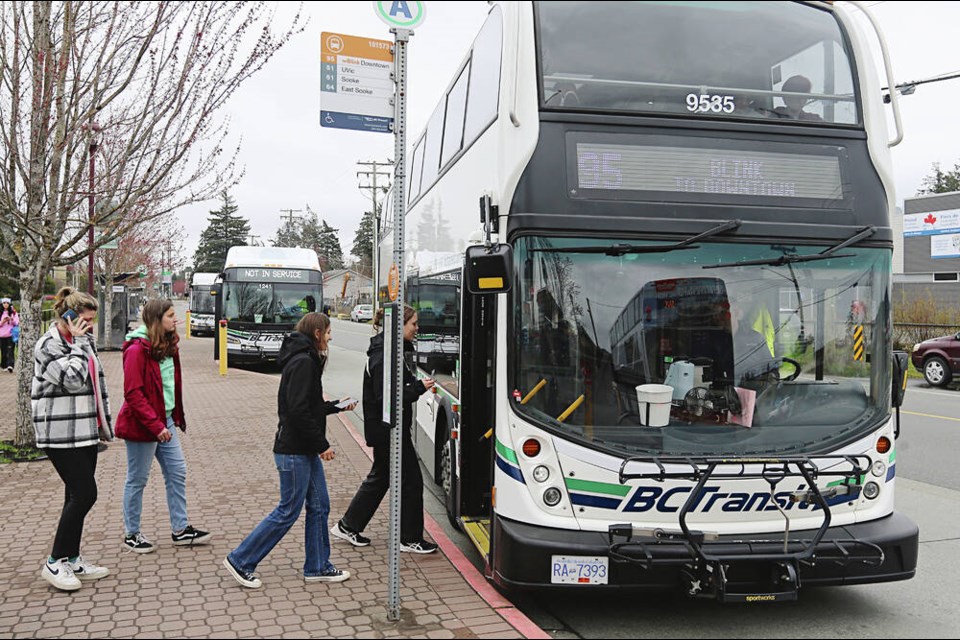Trevor Bodnar, Noah Scott and Yasin Derdak were the first passengers to board B.C. Transit’s new Blink RapidBus Route 95 at its downtown terminus on Government Street beside the legislature for its scheduled 12:25 p.m. run to Langford on Monday.
The three are transit enthusiasts, who like to ride on buses for fun. Bodnar, who lives in Vancouver, even has an Instagram account (@trevors_transit_photography) with photographs of buses he has ridden.
The teenagers joined a rugby player from South Africa going to practice, a senior who rides the bus almost every day, a young woman on her way to work and others who hopped on Greater Victoria’s first designated rapid transit service, travelling between downtown Victoria and the West Shore.
The new Route 95, replacing Route 50, has been designed to provide faster, more frequent service. B.C. Transit plans to provide similar RapidBus service between Uptown and the University of Victoria, and downtown and Swartz Bay ferry terminal; no start dates have been announced for those services.
Bodnar, 19, boasts of having ridden on public transit in Vancouver, Kamloops, Portland, Whistler and Nanaimo.
“Victoria’s system is pretty good for its size,” said Bodnar, whose uncle and grandfather were both bus drivers in Vancouver.
He said that he sees parallels between Victoria’s new service and Vancouver, which launched rapid transit routes in 2019.
“The Vancouver system has an advantage because they have prioritized transit signals (for traffic lights) in town that give them just a little extra boost,” said Bodnar.
Like Vancouver, Victoria’s newest bus route takes advantage of bus-friendly infrastructure along parts of its route, including priority bus lanes along portions of Douglas Street and the Trans-Canada Highway.
Riders on Monday were met with new bus signs topped with orange. The orange will signify to riders that they are about to board a RapidBus.
The new service follows the same route as the old 50 but with fewer stops. That news did not sit well with some.
“I have had excellent service with the former 50 route,” said rider Pam Madsen. “The stops they eliminated were all well-used. I think the local government has paid no attention to improving the infrastructure, especially considering the influx of people to the area.”
Levi Megenbir, senior transit planner for B.C. Transit, said that the changes were necessary to streamline the new service. Riders can expect a bus to arrive every seven to eight minutes during peak travel times.
“We will build on our vision to outperform the personal automobile and anticipate time savings for customers,” he said.
The biggest change riders will immediately see is the addition of 21 trips daily, Monday to Friday, an increase of about 12 per cent. During non-peak travel periods, transit riders can expect a bus to arrive at least every 15 minutes between 7 a.m. and 10 p.m. Monday to Saturday and 8 a.m. to 10 p.m. on Sundays.
The new Blink RapidBus route resulted in changes to Route 61 Sooke. During non-peak travel times customers will be required to transfer to Route 95 at the Langford Exchange if their destination is downtown Victoria.
On top of that, riders will need to pay an additional fare for the transfer if they don’t have a day or monthly pass.
“That really sucks for us living in Sooke and needing to go downtown,” said Carla Collins, who was travelling with her family and her son’s girlfriend downtown. “But today it wasn’t a long wait (to transfer between buses), so it wasn’t bad. The good news is the frequency of the new service. Under the old schedule we sometimes had to wait 60 minutes for a bus. If it is down to 15 minutes — like they say — it will be a vast improvement for us.”
Welcoming passengers, old and new, onto the bus on Monday was Leah Pearson, a transit operator on the old Route 50, on and off, for the last 14 years.
Although the bus was equipped with an automated recording of upcoming stops Pearson could be heard warning passengers used to alighting at certain stops that they would have to make adjustments to their routine.
“There will be growing pains as far as stops go. The loss of certain stops are going to throw some people off,” said Pearson, who has the option of driving a different route five times a year.
Should passengers complain to her, she can make their concerns heard by filling out internal “service comment sheets” she forwards to management.
She said that she has seen an uptick in passengers in the last few years, probably due to inflation and the cost of gas.
The biggest change in the time she has been behind the wheel travelling between downtown Victoria and the West Shore has been the creation of the priority bus lanes along Douglas Street and the Trans-Canada Highway.
“They have helped, big time,” she said.
>>> To comment on this article, write a letter to the editor: [email protected]



